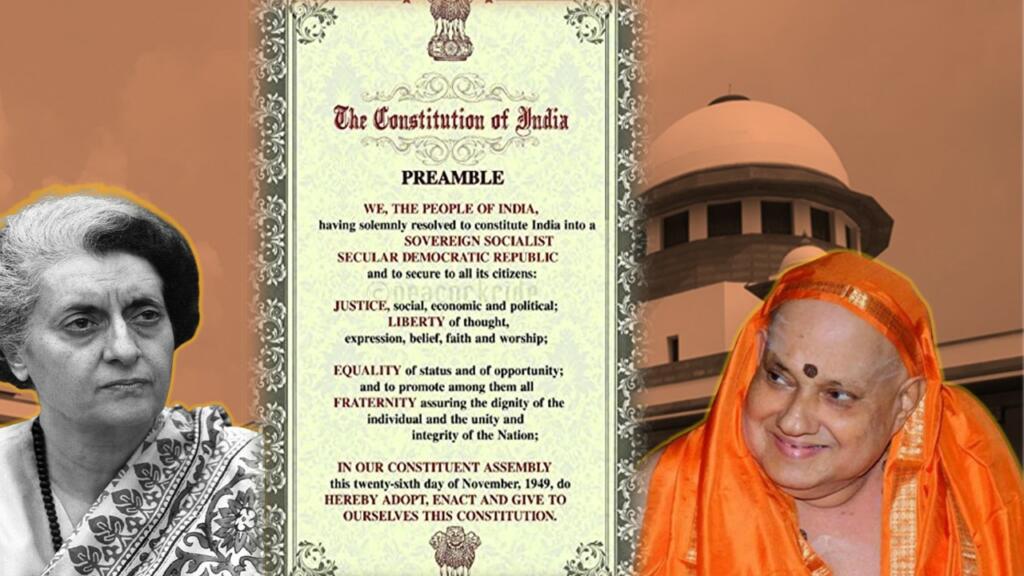The Preamble, the arch of the Constitution, is basically the prologue to the Constitution. The essence of the spirit of the citizens is encapsulated in this holy document. The “Preamble” is rightly phrased as the “identity card of the Constitution” by the legendary Nani Palkivala. It assures socio-economic justice to all Indian citizens and guides the legal fraternity in upholding the Rule of Law in society.
However, the Preamble and the Constitution together have matured along with the democratic journey of the nation. In all, there have been 105 amendments to the Constitution of India. Nevertheless, the most draconian change was brought about by PM Indira Nehru Gandhi, under the guise of emergency, with the pessimistic 42nd Amendment, 1976.
Indoctrination of the Preamble
The task of bestowing the people with a preamble was attributed to the Constituent Assembly. At first, it was suggested that the Preamble be omitted from the Constitution. Contrarily, Maulana Hasrat Mohani and Shri KM Munshi both objected to the idea. Subsequently, Maulana Hasrat Mohani made three changes to the draft Preamble.
The first of which was the substitution of the Sovereign Federal Republic or Sovereign Independent Republic for the Sovereign Democratic Republic as the country, which was rejected. Next, a suggestion was made to rename India the Union of Socialist Republics, based on the USSR model, which was also rejected. Lastly, another amendment was sought to introduce “In the name of God” or “In the name of Gandhiji” in the preamble, which too failed on the floor of the house by a 68-41 split.
Also read: The most iconic Indian case ever: 1973, Kesavananda Bharati vs State of Kerala – Part 3
A Failed Attempt to Paint the Preamble with Communism
The effort to paint the preamble with a communist flavour was made by Shri Brijeshwar Prasad. He proposed the inclusion of the words “secular and socialist” in the preamble, which was disregarded. In another attempt, Shri KT Shah introduced the amendment proposing to include “secular, federal, and socialist” in Clause (1) of Article 1, which was also rejected.
Consequently, the Objectives Resolution was introduced in the Constituent Assembly on December 13, 1946, and was approved on January 22, 1947. As a consequence, the original Preamble was adopted by the Constituent Assembly on November 26, 1949, declaring India a “Sovereign Democratic Republic,” which became effective on January 26, 1950. Later, the Indira Gandhi regime, however, succeeded in adding the term secular and socialist in the constitution in 1976.
Also read: The most iconic Indian case ever: 1973, Kesavananda Bharati vs State of Kerala – Part 2
Judiciary Dictum on the Preamble
The Preamble is regarded as the heart and soul of the spirit of the Constitution. It highlights the dedication and vision of a nation in contrast to the misery and sacrifices made to achieve independence. The language of the preamble emphasises a number of the fundamental principles and tenets upon which the Constitution rests.
The spirit of the Preamble, therefore, becomes significant and has been subjected to judicial scrutiny on multiple occasions. The problematic question of whether the Preamble is a part of the Constitution or not was dealt with in two leading cases by the Apex Court.
Also read: The most iconic Indian case ever: 1973, Kesavananda Bharati vs State of Kerala
Berubari case: Preamble not part of Constitution
The Berubari case was brought up for examination by an eight-judge panel led by Chief Justice B.P. Sinha. The case was a Presidential Reference under Article 143(1) of the Indian Constitution regarding the implementation of the Indo-Pak Accord relating to the Berubari union and exchange of enclaves.
The opinion of the court was given in unanimity by Justice Gajendragadkar. The renowned Constitutional Bench held that the Preamble to the Constitution contains the declaration made by the people of India in exercising their sovereign will. The court relied on the Golaknath case.
And it was highlighted that the Preamble is undoubtedly a key to unlocking the minds of the Constitution’s framers and may reveal the general purposes for which they made the various provisions in the Constitution, but it is not itself a part of the constitutional document.
Also read: The 1995 case that cemented the notion of ‘Hinduism is a way of life’ and why it is not right
Kesavananda Bharati case: preamble part of the Constitution
In the Kesavananda case, which was decided in 1973, the Supreme Court reversed earlier rulings and acknowledged that the preamble might be used to interpret parts of the Constitution that are unclear and give rise to conflicting interpretations.
Therefore, creating history, the court held that the Preamble to the Constitution of India is a part of the Constitution, neither a source of power nor a source of limitations, and has a significant role to play in the interpretation of statutes, as well as in the interpretation of provisions of the Constitution.
Further, in 1995, in the LIC case, the Apex Court reiterated that the Preamble is an integral part of the Constitution and cannot be alienated from the document. Nonetheless, the discussion on the preamble cannot be completed taking into account the Mandal Commission case, where the Apex Court highlighted the significance, value, and message of the preamble.
According to Hon’ble Justice B.P. Jeevan, the fourfold goal of securing to its citizens justice, liberty, equality, and fraternity demonstrates statesmanship of the highest order under the Indian Constitution.
Support TFI:
Support us to strengthen the ‘Right’ ideology of cultural nationalism by purchasing the best quality garments from TFI-STORE.COM
Also Watch:
https://www.youtube.com/watch?v=sjw68IrUvzc
